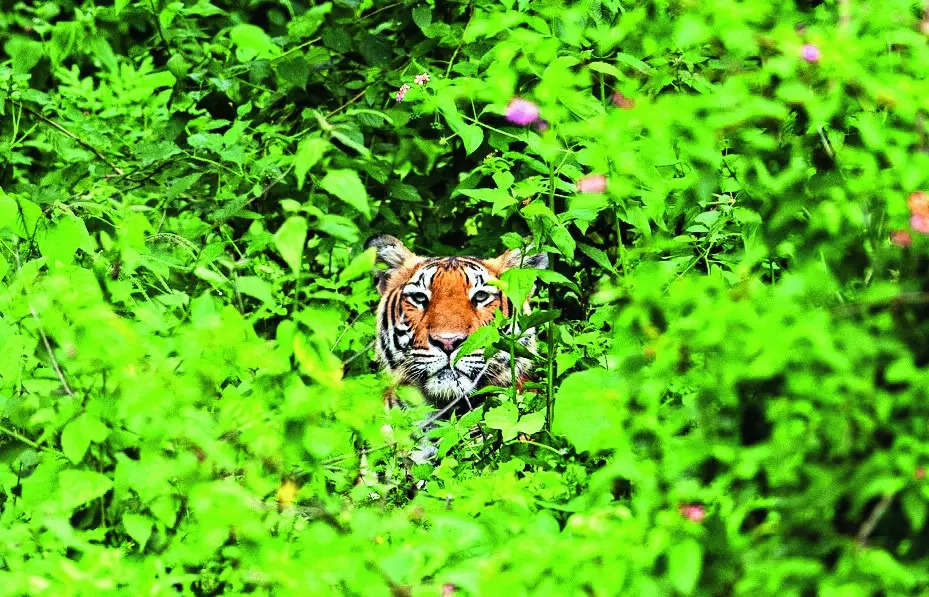Back
Loading...
Article
HOME / ARTICLES

We Revere All Life-Forms By Conserving Tigers
Jul 29, 2023, 13:30

Today, I come before you to discuss a matter of utmost importance — conservation of tigers. These magnificent creatures are not merely a part of our natural world; they hold deep spiritual significance as well. In the timeless wisdom of the Bhagwad Gita, we find teachings that resonate with the urgency and need for tiger conservation.
In the Gita verse 9:17, Krishn says, “Pitaham asya jagato mata dhata pitamaha” -- meaning, I am the father; I am also the mother, the sustainer, and the grandsire. ‘I’ means not Krishn but the pervasive spirit of existence that holds and sustains it. The Ved says, “Ishavasyam idagum sarvam, yat kinchit jagatyam jagat”. This spirit is existing in and through the whole existence. Thus, the Gita emphasises interconnectedness, the sense of belonging and source of support of all beings existing on this earth. Viewed from this perspective, every creature, big or small, has the right to live. This profound insight highlights our responsibility to care for the natural world around us with all its inhabitants, fauna, and flora, which includes the majestic tiger. It is our sacred duty to ensure its survival and the preservation of its habitats. By conserving tigers and their habitats, we embody the spirit of ahimsa and cultivate a deep reverence for all life-forms.
Every creature has a role to play and has something to contribute to this harmonious existence. In light of this, preservation of tigers is also essential for balance and harmony. Tigers, as powerful apex predators, embody the intricate web of life. Just as each thread in a tapestry is vital to the beauty of the whole, the presence of tigers in our ecosystem is essential for its balance and harmony.
Just as Krishn says in the Gita verse 6:10, “Ekaki yatacittatma nirasiraparigrahah”, meaning, remaining in solitude, alone with the mind and body controlled, free from hope and greed -- tigers are solitary animals and maintain their own territory. Hence, they have their own status in the human world. Every twelfth year of the Chinese calendar is considered the year of tiger and children born in that year are considered lucky and powerful. In Hindu mythology, the tiger is Goddess Durga’s vaahan, vehicle.
Due to greedy human nature, tigers have been hunted for thousands of years. It would be an act of gratitude to save these magnificent creatures as their numbers have significantly declined. We need to be proud of our country that launched Project Tiger in 1973 for conservation of tigers.
We need to have a wholistic view of the world. Most of the time we are restricted by our own boundaries of ‘me and mine’, which exclude others. Wholistic living calls for an inclusive approach. We need to develop a vision of inclusivity of all beings, and to conserve tigers with selfless dedication. The positive results of this act will echo through generations to come.
A combination of grace, strength, agility, and enormous power has earned the tiger its place of pride as the national animal of India. Hence, we need to preserve it, both with compassion and pride.
Written by-Swami Sukhabodhananda
In the Gita verse 9:17, Krishn says, “Pitaham asya jagato mata dhata pitamaha” -- meaning, I am the father; I am also the mother, the sustainer, and the grandsire. ‘I’ means not Krishn but the pervasive spirit of existence that holds and sustains it. The Ved says, “Ishavasyam idagum sarvam, yat kinchit jagatyam jagat”. This spirit is existing in and through the whole existence. Thus, the Gita emphasises interconnectedness, the sense of belonging and source of support of all beings existing on this earth. Viewed from this perspective, every creature, big or small, has the right to live. This profound insight highlights our responsibility to care for the natural world around us with all its inhabitants, fauna, and flora, which includes the majestic tiger. It is our sacred duty to ensure its survival and the preservation of its habitats. By conserving tigers and their habitats, we embody the spirit of ahimsa and cultivate a deep reverence for all life-forms.
Every creature has a role to play and has something to contribute to this harmonious existence. In light of this, preservation of tigers is also essential for balance and harmony. Tigers, as powerful apex predators, embody the intricate web of life. Just as each thread in a tapestry is vital to the beauty of the whole, the presence of tigers in our ecosystem is essential for its balance and harmony.
Just as Krishn says in the Gita verse 6:10, “Ekaki yatacittatma nirasiraparigrahah”, meaning, remaining in solitude, alone with the mind and body controlled, free from hope and greed -- tigers are solitary animals and maintain their own territory. Hence, they have their own status in the human world. Every twelfth year of the Chinese calendar is considered the year of tiger and children born in that year are considered lucky and powerful. In Hindu mythology, the tiger is Goddess Durga’s vaahan, vehicle.
Due to greedy human nature, tigers have been hunted for thousands of years. It would be an act of gratitude to save these magnificent creatures as their numbers have significantly declined. We need to be proud of our country that launched Project Tiger in 1973 for conservation of tigers.
We need to have a wholistic view of the world. Most of the time we are restricted by our own boundaries of ‘me and mine’, which exclude others. Wholistic living calls for an inclusive approach. We need to develop a vision of inclusivity of all beings, and to conserve tigers with selfless dedication. The positive results of this act will echo through generations to come.
A combination of grace, strength, agility, and enormous power has earned the tiger its place of pride as the national animal of India. Hence, we need to preserve it, both with compassion and pride.
Written by-Swami Sukhabodhananda










